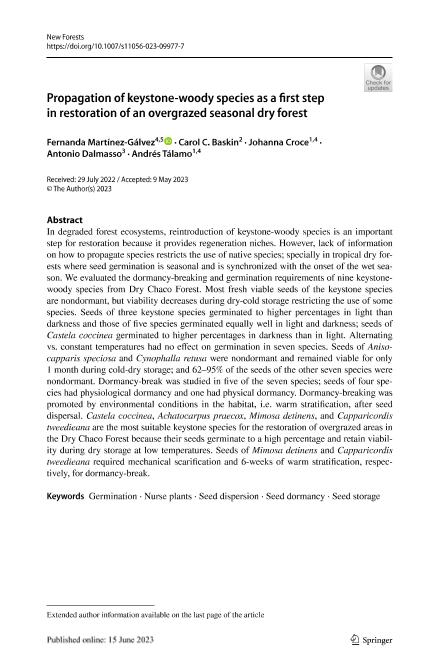Artículo
Propagation of keystone-woody species as a first step in restoration of an overgrazed seasonal dry forest
Martínez Gálvez, María Fernanda ; Baskin, Carol C.; Croce, Johanna
; Baskin, Carol C.; Croce, Johanna ; Dalmasso, Antonio Daniel
; Dalmasso, Antonio Daniel ; Tálamo, Andrés
; Tálamo, Andrés
 ; Baskin, Carol C.; Croce, Johanna
; Baskin, Carol C.; Croce, Johanna ; Dalmasso, Antonio Daniel
; Dalmasso, Antonio Daniel ; Tálamo, Andrés
; Tálamo, Andrés
Fecha de publicación:
06/2023
Editorial:
Springer
Revista:
New Forests
ISSN:
0169-4286
Idioma:
Inglés
Tipo de recurso:
Artículo publicado
Clasificación temática:
Resumen
In degraded forest ecosystems, reintroduction of keystone-woody species is an important step for restoration because it provides regeneration niches. However, lack of information on how to propagate species restricts the use of native species; specially in tropical dry forests where seed germination is seasonal and is synchronized with the onset of the wet season. We evaluated the dormancy-breaking and germination requirements of nine keystonewoody species from Dry Chaco Forest. Most fresh viable seeds of the keystone species are nondormant, but viability decreases during dry-cold storage restricting the use of some species. Seeds of three keystone species germinated to higher percentages in light than darkness and those of fve species germinated equally well in light and darkness; seeds of Castela coccinea germinated to higher percentages in darkness than in light. Alternating vs. constant temperatures had no efect on germination in seven species. Seeds of Anisocapparis speciosa and Cynophalla retusa were nondormant and remained viable for only 1 month during cold-dry storage; and 62–95% of the seeds of the other seven species were nondormant. Dormancy-break was studied in fve of the seven species; seeds of four species had physiological dormancy and one had physical dormancy. Dormancy-breaking was promoted by environmental conditions in the habitat, i.e. warm stratifcation, after seed dispersal. Castela coccinea, Achatocarpus praecox, Mimosa detinens, and Capparicordis tweedieana are the most suitable keystone species for the restoration of overgrazed areas in the Dry Chaco Forest because their seeds germinate to a high percentage and retain viability during dry storage at low temperatures. Seeds of Mimosa detinens and Capparicordis tweedieana required mechanical scarifcation and 6-weeks of warm stratifcation, respectively, for dormancy-break.
Palabras clave:
Germination
,
Nurse plants
,
Seed dispersion
,
Seed dormancy
Archivos asociados
Licencia
Identificadores
Colecciones
Articulos(IADIZA)
Articulos de INST. ARG DE INVEST. DE LAS ZONAS ARIDAS
Articulos de INST. ARG DE INVEST. DE LAS ZONAS ARIDAS
Articulos(IBIGEO)
Articulos de INST.DE BIO Y GEOCIENCIAS DEL NOA
Articulos de INST.DE BIO Y GEOCIENCIAS DEL NOA
Citación
Martínez Gálvez, María Fernanda; Baskin, Carol C.; Croce, Johanna; Dalmasso, Antonio Daniel; Tálamo, Andrés; Propagation of keystone-woody species as a first step in restoration of an overgrazed seasonal dry forest; Springer; New Forests; 55; 2; 6-2023; 363-382
Compartir
Altmétricas



